DITA CMS Solutions: Case Studies
At Human Science, we have been providing solutions for effectively managing large volumes of documents to numerous clients for many years.
The key technologies for this are DITA & CMS, and in terms of technology and know-how in this field, Human Science has been at the forefront of the industry.
The clients we have assisted so far come from various industries and company sizes, and they face a wide range of challenges, each requiring different processes for resolution.
In our company, we have addressed our clients' unique challenges using methods centered around DITA & CMS in various cases, working towards solutions for those challenges.
Here, we will provide a detailed introduction to case studies of Human Science DITA & CMS solutions.
Although we can only introduce a few examples here, there are many more cases available. Please feel free to contact us for more details.
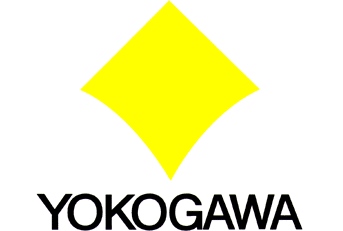
Case 1: Yokogawa Electric Corporation
Support for topic writing and quality improvement for DITA promotion
Yokogawa Electric Corporation (http://www.yokogawa.co.jp/) has adopted a CMS using DITA for document production, achieving reductions in typesetting costs and efficient translation management.
Human Science has worked on improving the quality of writing under the theme of thorough topic-oriented writing to further advance its initiatives.
As a specific measure, we conducted an evaluation and analysis of existing manuals from the perspectives of ease of reuse, clarity, readability, and searchability.
- ■Customer Challenges
-
①Although DITA and CMS have been implemented, the expected benefits have not been fully realized.
The efficiency gained from the reuse of documents, which is a feature of DITA, was insufficient.
②Poor document quality
There was room for improvement in terms of clarity, readability, and searchability of the text itself.
- ■Process
-

STEP1: Selection of Target Manual
- Select the manuals to be analyzed for the causes of issues with the cooperation of the client's representatives.
STEP2: Analysis of the Factors Behind the Issues
- Determine the analysis perspectives for the target manual and analyze the factors causing issues.
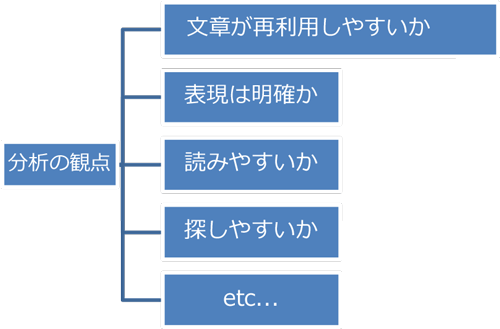
STEP3: Conducting the Reporting Meeting
- Compiled the results of the analysis of the issues into a report and held a presentation for the stakeholders.
- Stakeholders from various levels participated in the reporting session, creating a forum for consensus on the direction of document improvement.
- [Report Example]
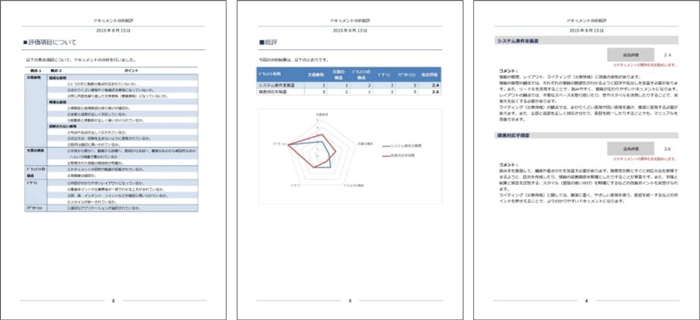
STEP4: Holding Training Seminars
- We will hold a training seminar for writers who will actually be responsible for writing, using a manual that has been agreed upon as the subject.
- [Training Content]
- ・Training Schedule: 1 day
- ・Text: Use the customer's actual manual as training material.
- ・Main lecture topics: "Improving Table of Contents Structure", "Polishing Written Expression", "Reconsidering Layout", etc.
- ・Group Discussion: Discuss in groups how improvements can be made using the topics from the exercises.
- ・Program: (See the figure below)
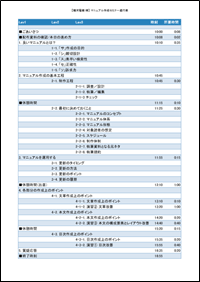
- >>【Related Solutions】Training & Seminars
- ■Effect
-
①Acquisition of Topic-Oriented Writing for Enhanced DITA Implementation Effects
Our instructors, with years of writing experience, focused on improvement points from an objective perspective during the lectures, allowing you to acquire improvement points that are often overlooked in in-house processes and effective solutions.
We received feedback from our customers saying, "Although there was a vague awareness that improvements to the manuals were necessary, we struggled to make fundamental changes. However, through the seminar, we received objective feedback from documentation professionals, which led to fundamental improvements in the manuals."
②Achieving efficiency and reducing man-hours through process improvement
- By incorporating processes such as creating samples to share completion images, sharing revision policies, and sharing checkpoints during reviews, the consensus-building with stakeholders has become smoother. As a result, we have achieved one of the goals of DITA implementation, which is to reduce man-hours.
Case 2: Edison Corporation
CMS (Author-it) implementation consulting, manual creation
Edison Corporation (http://www.e-mall.co.jp/) develops and provides systems for waste generators, management companies, and industrial waste collection, transportation, and processing operators.
We provide manuals for users of each system, but when developing the comprehensive management system for the industrial waste collection, processing, and recycling industry, "Environmental General R," you had the following challenges.
- ■Customer Challenges
-
①The number of inquiries to customer support is not decreasing at all
- All manuals for the old system were produced in-house, but they were not being utilized sufficiently by users, and the number of inquiries to customer support was not decreasing at all.
②Reduction of manual maintenance workload
- Maintaining the manuals was taking an enormous amount of time, and there was a need to significantly reduce the working hours.
③Easily customize manuals for each customer
- To customize system functions for each customer, a mechanism was needed to easily customize manuals for each customer as well.
- ■Process
-

STEP1: Proposal of Solutions for Problem Solving
- We propose topic writing and the implementation of CMS (Author-it *) as the optimal solution for solving your challenges.
- * "Author-it" is a product of Author-it Software Corporation.
STEP2: Analysis and Evaluation of the Old Manual
- We evaluate and analyze the old manual, and propose improvement policies focusing on clarity, searchability, and maintainability.
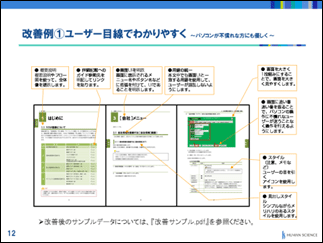
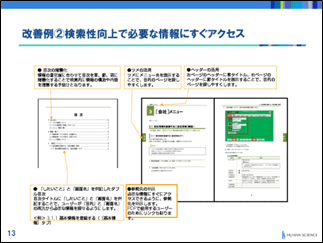
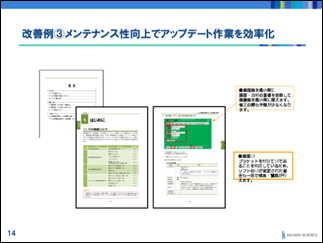
STEP 3: Manual Production with CMS Implementation
- Designed templates with a focus on clarity and ease of search.
- Writing topic-based documents according to templates on Author-it.
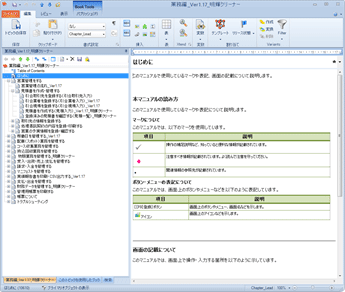
STEP4: Manual Production Training
- Conducting training on the operation and management methods of the CMS for manual production personnel.
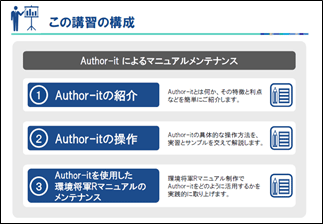
- ■Effect
-
①Improvement of Productivity
By leveraging the following features of "Author-it", we have achieved improved work efficiency.
- Easy to learn during implementation due to its operation being similar to Word.
・Excellent at managing content on a topic basis, making it easy to revise manuals and customize for each customer.
- Since topic writing is possible, it allows for writing by multiple technical writers.
②Improvement of Maintainability
By writing clear articles on a topic-by-topic basis, sharing and reusing articles has become easier, and maintainability has improved.
In addition, we held training sessions on how to operate and manage "Author-it" for manual production personnel, reducing the burden during manual customization.
③Easy customization of manuals for each customer
By sharing and reusing content at the topic level with Author-it, it has become easier to customize manuals according to the functional support for each customer.
●Combination of necessary parts (explanatory articles) for each customer
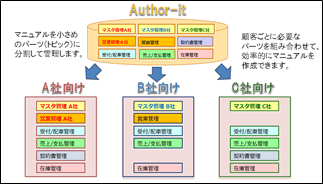
●Bulk update of common articles for each company
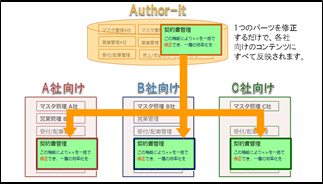
[Case 3] Domestic Printer Development and Manufacturing Company A
Structured design for DITA conversion, topic writing, XML (DITA) editing, English version deployment, CMS proposals
The manuals that Company A has traditionally produced were manuals formatted in FrameMaker and output in PDF format.
The production policy was reconsidered, and it was decided to change to an online manual while utilizing existing assets. Additionally, this was an opportunity to convert the manual to DITA.
- ■Customer Challenges
-
It was necessary to utilize existing manual data while transitioning the manuals to an online format and converting them to DITA.
- ■Process 1: DITA Conversion
-

STEP1: Structured Design
- Create a structured specification document as a rule for multiple writers to work in parallel, in accordance with DITA standards (rules).
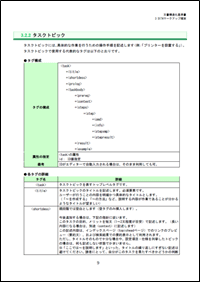
STEP2: Topic Writing
- Rewrite the existing manual text into topic writing based on the guidelines created in STEP1 (rewrite rules, style guide).
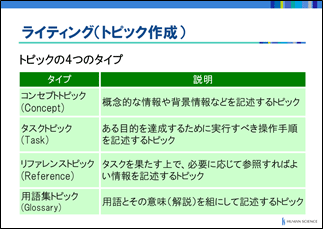
STEP3: XML (DITA) Editing
- Adopting oXygen as the authoring tool.
- oXygen was chosen because it is easy to edit and has robust features such as file referencing and search functionality.
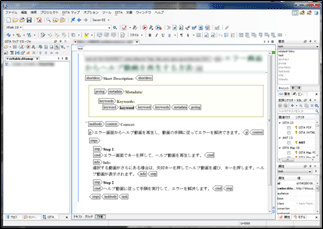
STEP 4: HTML and PDF Conversion Output
- Using WebWorks ePublisher to perform styling and output for HTML and PDF.
- We used JavaScript and other technologies to create visually appealing dynamic HTML files.
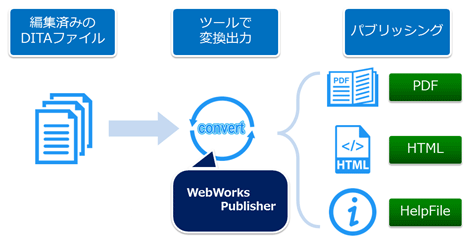
- ■Process ②: Creation of English Version
-

STEP1: Japanese to English Translation
- Translation of DITA-formatted Japanese manuals into English.
- >>【Related Solutions】English Translation / Multilingual Translation
STEP2: XML (DITA) Editing
- Editing using oXygen as the authoring tool.
STEP3: HTML, PDF Conversion Output
- Using WebWorks Publisher to perform styling and output for HTML and PDF.
- We have created visually appealing dynamic HTML files using JavaScript and other technologies.
- ■Process ③: CMS Implementation Proposal
-

STEP1: CMS Implementation Consulting
- Analyze existing documents and select the most suitable CMS from many options.
- Further verification of the effects of CMS implementation.
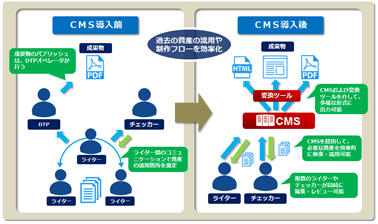
STEP2: Introduction of CMS
- Template design, structuring of unstructured documents, and data migration are implemented.
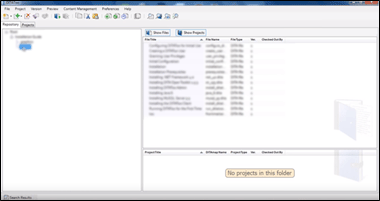
STEP 3: Operational Training After CMS Implementation
- Step-by-step level-up of CMS operation and management methods for manual staff.
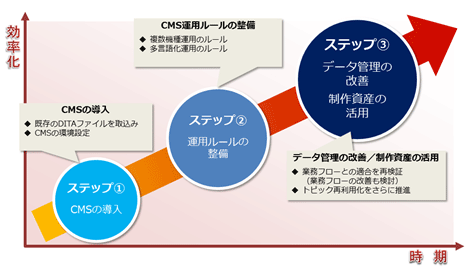
- ■Effect
-
①Standardization of Manual Production Methods
By standardizing the manual production process, we have achieved a departure from the traditional, person-dependent manual creation methods.
②Improvement of productivity through one-source multi-format
We have made it easy to convert from a single source to multiple output formats such as HTML and PDF, achieving significant improvements in both speed and cost.
Cost Estimate
We will provide a customized estimate.
Please feel free to contact us.


